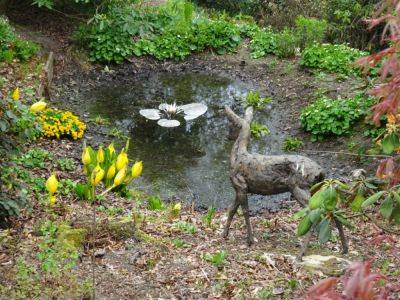Summer hyacinth (Ornithogalum candicans) is a delicately pretty flowering plant which adds dynamic interest to flower beds and mixed borders. Though this unique bulb is relatively easy to grow, becoming familiar with its needs and growth habit will ensure that plants thrive for years to come.
Floral Sunshine
04.01.2024 - 08:47 / finegardening.com / Joseph Tychonievich
Yellow is a polarizing color for flowers. Some people think it is brassy and loud and unpleasant. Others find it sunny and cheerful. The sunny warmth of yellow can cheer up a dark garden, and looks great when combined with darker colors. Today we’re sharing some favorite yellow blooms – what are yours?
Any list of yellow flowers has to include daffodils… the sunny essence of spring. But there is a lot of diversity in daffodils beyond the classic big trumpets. This is Narcissus bulbicodium (Zone 6 – 9), sometimes called the hoop petticoat daffodil. It has a particularly elegant, miniature take on the classic daffodil.
Anemone ranunculoides (Zone 4 – 8) is a bright little woodlander, spreading slowly to make a clump of sunshine.
This little yellow flower is the lakeside daisy (Tetraneuris herbacea, Zone 4 – 8). It is a wildflower native to just a handful of spots on the shores of the Great Lakes. Though quite rare in the wild, it makes a great garden plant, with masses of yellow flowers in May.
Zinnia grandiflora (Zone 5 – 9) is a miniature, hardy, perennial species of zinnia native to western North America. Unlike the familiar annual species, this spreads out to make a long-blooming ground cover, with yellow flowers that keep coming all summer long. It is very drought tolerant, but doesn’t do well in heavy, wet soils.
Japanese kerria (Kerria japonica ‘Pleniflora’, Zone 4 – 9) is a slightly sprawling shrub that blooms for a very long period with bright yellow flower. The great feature is that it is very tolerant of even quiet deep shade, still blooming in spots where most plants won’t.
Closer look at the Japanese kerria blooms. This is the double flowered form, there are also singles with just five petals to each bloom.

Grow Pearlbush (Exochorda Racemosa) For True Floral Treasures
When you grow pearlbush, you are adding a flourish of rare beauty to your garden. With its brilliant white flowers, this shrubs makes a beautiful plant for a border or hedge. Common pearlbush (Exochorda racemosa) is known for its dazzling display of bright white flowers in early spring. These flowers blossom from pearl-shaped buds which gives this shrub its name.

Easy Fruits To Grow For Complete Beginners
If you are a beginner, knowing some easy fruits to grow can get you on the path to self sufficiency and well being. Growing our own food allows us to control what’s in it, making us healthier. Fruit is one of our main dietary requirements and a pleasure to grow in a home garden.

Bingo Blooms: How To Make Your Gardening a Floral Adventure
Among all the hobbies you could choose to engage in during your free time, gardening should definitely be top of that list. The therapeutic feel and connection with nature you get to experience even while enjoying the fruits of your labour is one of its enticing perks. But all this might just be an added advantage if you're focused on the beautiful landscapes and serenity it creates.

Six on Saturday: Keeping Busy
Busy Lizzies continue to amaze me every year with their flower power – those above have been flowering since the beginning of June and show no sign of stopping, despite a large degree of neglect by the gardener; however, a dose of frost would quickly send them packing.

Native Plants with Show-Stopping Autumn Color
In Issue 181, we got to know some of the plants that grace Mt. Cuba Center’s hot, sunny South Garden during the spring and summer months (10 Great Natives for a Sunny Border). The garden had been recently redesigned to showcase a collection of borderworthy natives that can take the heat of the Zone 7 summers in Hockessin, Delaware.

Summery floral drinks from the garden
After a couple of years living in the wasteland that was my allotment, my lavender plant has gone a little wayward and woody. The rosemary is the same way, really. They should have had an annual chop after flowering, to keep them nice and fresh. It’s possible that some serious remedial pruning later in the summer will shock them into more appropriate behaviour – but it’s not guaranteed. The garden wouldn’t be the same without rosemary and lavender (their flowers and their scents, their lovely flavours), but they’re easy plants to replace if they get out of control. (There’s nothing inherently wrong with a big, bushy lavender or rosemary, I just don’t have the space to let them grow.)

Floral Vistas Plan Before Planting
Greenery is all very well but I like to see swathes of colourful flowers. I try to envisage how mixed planting will shape up in terms of colour but generally my minds eye falls short when it comes to the imagination department. The best tip is to keep it simple with only a very limited number of varieties chosen because they are due to flower around the same time.

Trim a Straight and Floral Hedge
August is a good time to trim your hedges and create a neat appearance for autumn and winter.

A Splash of Floral Yellow sans-narcissus
You may see a splash of yellow if the Fawn decides to take a spring dip in the pond. The skunk cabbages are reputed to stink but these Lysichiton americanus are also named swamp lanterns so they flower well near the boggy pond.


